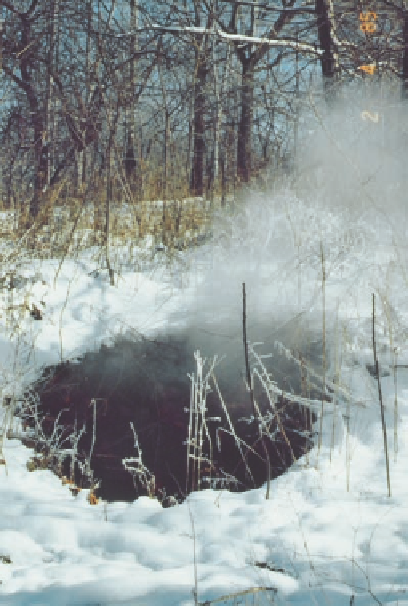Geology Reference
In-Depth Information
16.3. Characteristics of Fires in
Abandoned Coal Mines and
Waste Banks
This sinkhole formed above an underground
coal-mine fire in an abandoned mine located
in Renton, Pennsylvania. The sinkhole
formed when pillars of coal supporting the
roof of an underground mine burned. Sub-
sequently, the roof collapsed, forming the
sinkhole.
Photo: US Bureau of Mines, 1985.
Introduction
I
n the years that the Bureau of Mines worked to control fires in abandoned mines and coal waste banks, they
accumulated a significant amount of data on how such fires are started and how they spread. Evaluating the
characteristics of such fires enabled Bureau personnel
to develop innovative solutions to fire-control
problems.
Initiation of Coal-Mine Fires
A
ny fire requires three elements: fuel, oxygen, and an ignition source. In coal combustion, the fuel is the carbon in
the coal, and oxidation of coal occurs constantly. The temperature of the coal is a function of the rate of heat
generation versus the rate of heat loss. When these processes occur at the same rate, the temperature of the coal
remains constant. When the heat energy generated exceeds the rate of heat loss, the temperature of the reacting
system increases. Since the rate of heat generation is an exponential function of temperature and the rate of heat
loss is a linear function of temperature (Figure 16.3.1.), as the temperature increases, the reaction rate increases
faster than the heat loss. Ignition is a function of the amount of energy released by a reaction and the rate at which it
is released, as well as the rate at which energy is transferred from the reacting mass to the surroundings. The
reaction rate is a function of the concentration of reactants, carbon and oxygen, the surface area, particle size,
temperature, and activation energy.
Forced Ignition
There are two types of ignition, forced and spontaneous. In forced ignition, energy is added to the system to
increase the rate of reaction to the self-sustaining point. In spontaneous ignition, there is no external heat source;
natural reactions supply sufficient energy to sustain combustion. For AML fires, forced-ignition sources include
lightning, brush and forest fires, improperly controlled man-made fires, and spontaneous combustion in adjacent
materials. Although there are no data on how most AML fires actually start, lightning and other surface fires are





